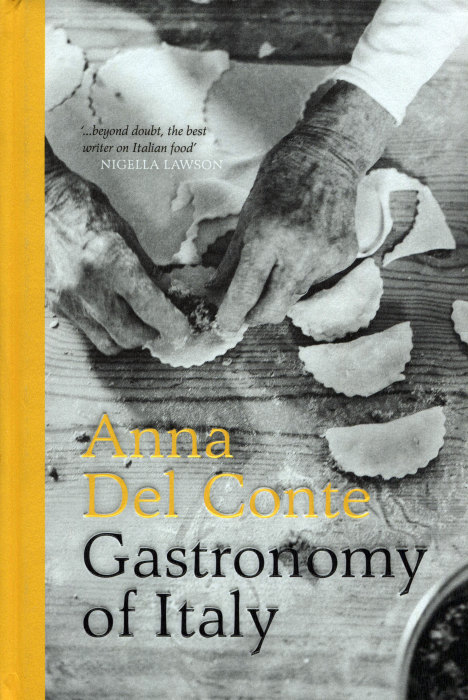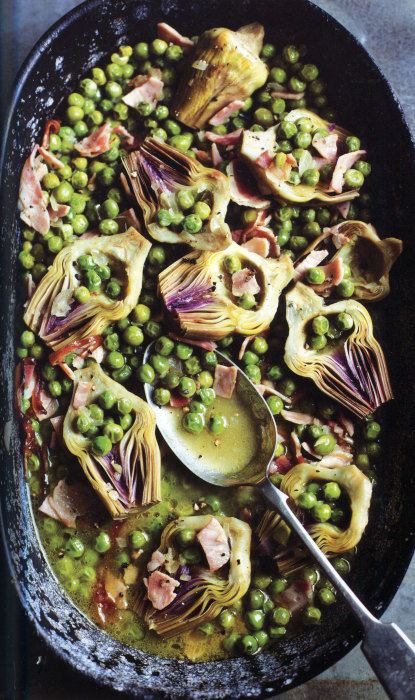This week’s Throwback Thursday cookbook is both old and new. This distinguished encyclopedia of Italian cuisine was first published in 1987 and in 2013 a new and vitally expanded edition was published by Pavillion Books. Author Anna Del Conte may not be widely known in the United States, but in Europe she is adored, awarded, and read with intensity.
The book cover has this quote from Nigella Lawson: “… beyond doubt the best writer on Italian food.” Anna has decades of cooking and writing under her apron. She is beyond expert. She is an Italian food maven and in Gastronomy of Italy she does double service.
First, this work is an encyclopedia of terms and key recipes from across the Italian spectrum. If you adore Italian food and want to understand the terminology of dishes and the defining characteristics of each region of Italy, then you want an easy chair, a cup of espresso, this book. It begins with abbacchio [baby lamb] and ends with zuppa inglese [custard and cake dessert]. In the almost 500 pages of the book, there are a thousand terms, ideas and concepts — all gracefully and swiftly presented.
And then there are the recipes. Some familiar, like ossobucco, and some that will trigger saliva, like the pasta pie encased in fried eggplant. Most of the recipes have striking photographs that amply prove we begin to eat with our eyes [and noses] far before out mouth samples that first bite.
A typical recipe is presented below: Artichokes with Peas. It typifies the recipes in the book and in Italian cuisine: a few ingredients, artfully cooked and presented with zest. The debate about which is better, Italian or French, can never be decided because they are so distinctively different. With its emphasis on excellence through simplicity, Italian cuisine is the easier one for us to master and enjoy in our home kitchens. [When I retire and can work on stock 24 X 7, I am going to master French!]
The most complicated recipe in this book, the one with far the most ingredients, is of course a dessert. A spiced fruit cake from Bologna served at Christmas. Otherwise, the recipes here are 6-12 ingredients long, including the spices, herbs and salt/pepper. Look for a post with this cake next December.
While we think of Italian cuisine as insularly Italian, Anna presents recipes showing the impact that other cultures have had in influencing the dishes we enjoy today. The Lamb with Horseradish Sauce reflects the heritage when much of Northern Italy was under the control of the Austro-Hungarian Empire. And the Pork Loin Braised in Milk with Spices [cinnamon!] is an indication of the deep heritage owed to Muslim traders and invaders.
The history of recipe evolution in Italy is as complex as any in the world. Italian gastronomy is anything but “simple.” If a list of ingredients is short, that brevity reflects centuries of recipe refinement. With her decades of experience, Anna is perhaps the only person now who has the knowledge and the perspective to so beautifully present this coverage of foods we all love.
Beauty goes beyond the words. The publisher, Pavillion Books, has fashioned a book that will delight readers. The layout, fonts, ample white space, and spectacular photos make this a book that is a “comfortable read.” You can, like me, begin on Page 1 and work your way to the end. Or, it can be equally enjoyable to just open the book to a random page and learn something that is probably new and surely fascinating.
Both for its value as the ultimate encyclopedia of Italian cuisine and for the authentic deliciousness of its recipes, Gastronomy of Italy is a book for food lovers of every cuisine.
Here’s a recipe from the book that is typically Italian, extravagantly beautiful, and a joy to taste.
Artichokes with Peas
Yield: Serves 4
Ingredients:
- 4 tender young artichokes
- Lemon juice
- 2 shallots or 1 small onion, finely chopped
- 1 ¾ ounces prosciutto, finely chopped
- 3 tablespoons olive oil
- 1 tablespoon unsalted butter
- ⅔ cup meat stock or chicken stock
- 2 cups shelled fresh garden peas, or frozen petits pois, thawed
- Salt and freshly ground black pepper
Preparation:
Prepare the artichokes by discarding the tough outer leaves, cutting off about ¾ inch from the tops and removing the stalks. Plunge the artichokes into cold water, to which 1 tablespoon of lemon juice has been added, to prevent them from turning black.
Put the shallots and prosciutto in a heavy saucepan or flameproof earthenware pot with the olive oil and butter. Sauté gently while you cut the artichokes in half (removing the furry chokes) and then – unless they are really small – into quarters. Dry them and add to the pan. Cook over medium heat for about 5 minutes, turning them over in the fat.
Pour the stock over the artichokes, add the fresh peas and season with a little salt and plenty of pepper. Cook until the artichokes and peas are tender — you might have to add a couple of tablespoons of water during the cooking if the dish seems too dry. If you are using frozen peas, add then about halfway through cooking the artichokes.


